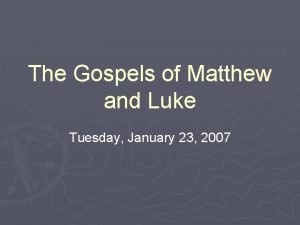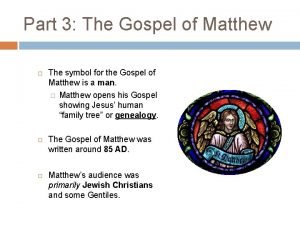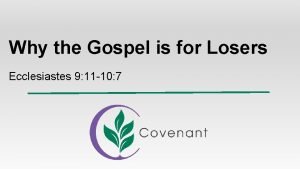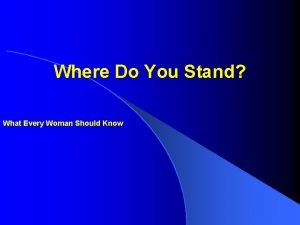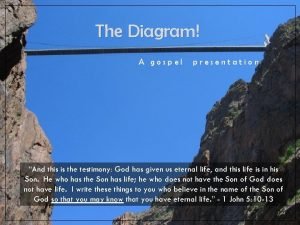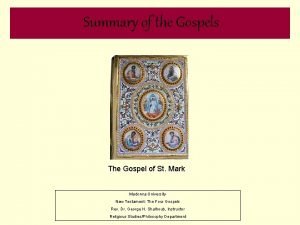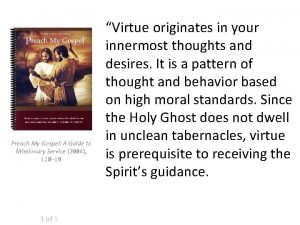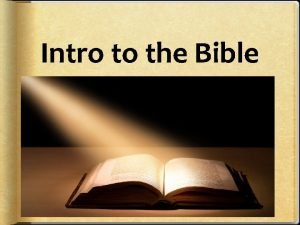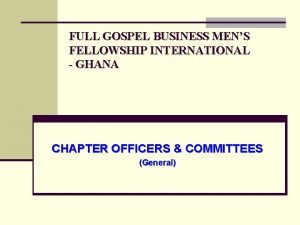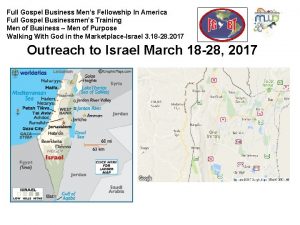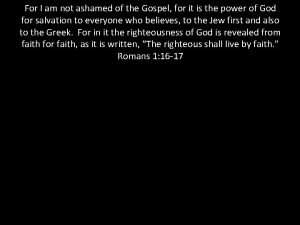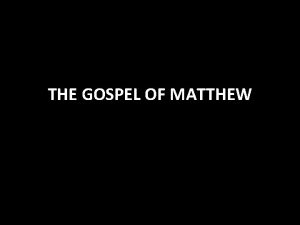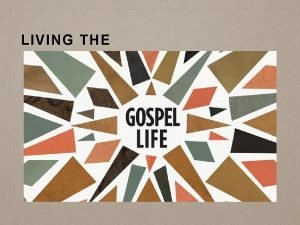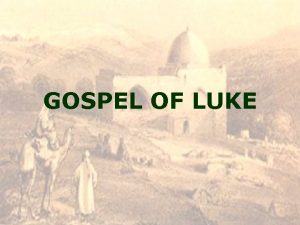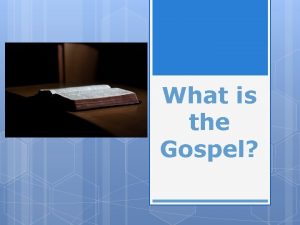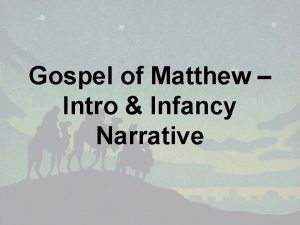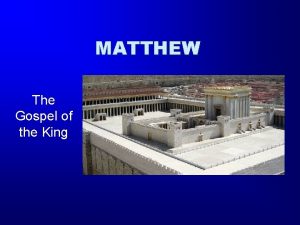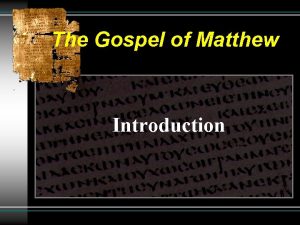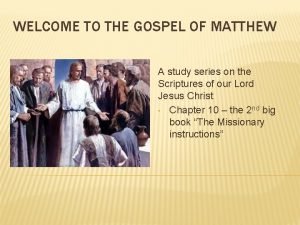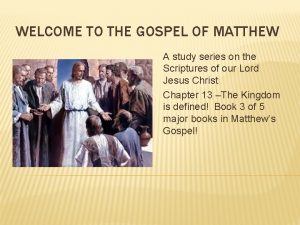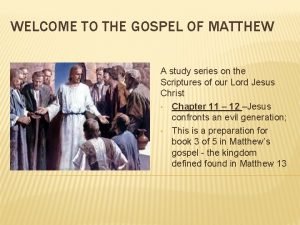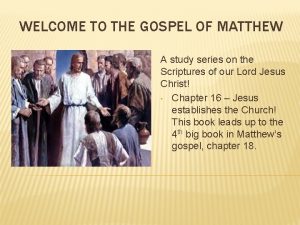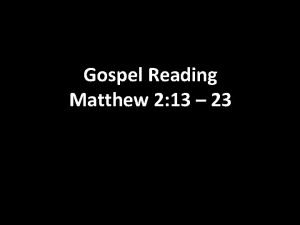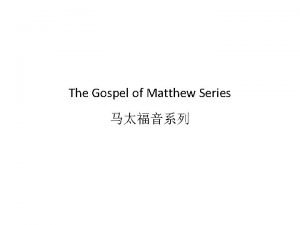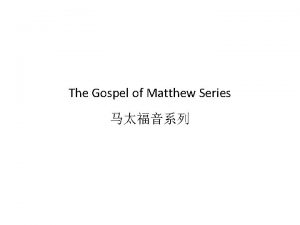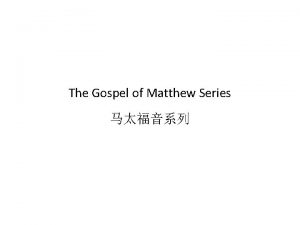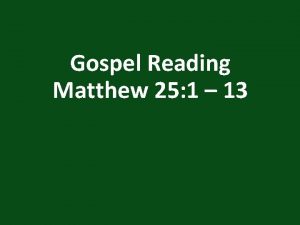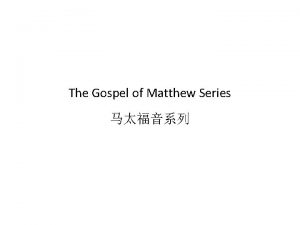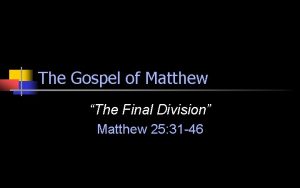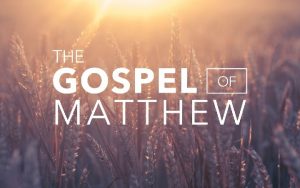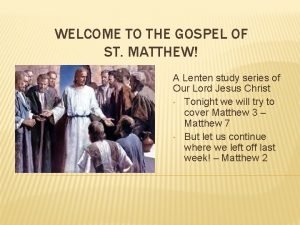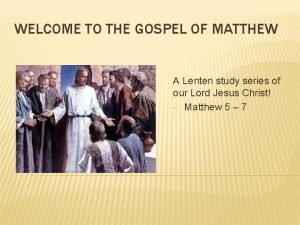WELCOME TO THE GOSPEL OF MATTHEW A study






























































- Slides: 62

WELCOME TO THE GOSPEL OF MATTHEW A study series on the Scriptures of our Lord Jesus Christ Chapter 14 – 15 – Travels and Ministry; instructing the 12! The Narrative to Book 4 out of 5 major books in Matthew’s Gospel!


A LITTLE REVIEW… � The eight parables of the kingdom in chapter 13 function and serve as a hinge between the two halves of Matthew’s gospel. � The eight parables draw a line in the sand between those who accept Jesus’ message and those reject it.

MORE REVIEW… � With the great divide of those who accept the Lord’s teaching and those who reject it, comes a shift to growing opposition among Jesus’ enemies and a fresh comprehension of the truth among his followers. � Taken together, these 8 parables paint an interesting and perhaps unexpected picture of the kingdom: � It will start out small, like the tiniest of the seeds, and hidden so it must be searched for with diligence.

A PICTURE OF THE KINGDOM PAINTED One who seeks the kingdom must be willing to give up everything in order to attain it and be confident that it will be worth every penny spent and even more. � While on earth it will contain “weeds” and “wheat” – both “good” and “bad” people – together. � People living in the kingdom are to exercise the same sort of mercy and patience that they receive from God. � They must be patient and refrain from the temptation to “pull out the weeds” prematurely. � Judgment belongs to God alone. � � What in the parables spoke to you personally? Sharing?

AS WE NOW MOVE ON… � Now carefully read chapter 14 -15. � As you read ask yourself the questions: � Who? � What? � When? � Where? � How? � Why?

MAIN THEMES OF CHAPTER 14 � In chapter 14, Jesus is going to start instructing his 12 apostles. � The main themes in this chapter are: � Herod Antipas martyrs John the Baptist. � Jesus feeds the 5, 000 � The Lord Jesus walks on water.

THE OUTLINE OF THE MARTYRDOM OF JOHN THE BAPTIST � � I. The Martyrdom of John (14: 1– 12) A. John is mistreated by Herod Antipas (14: 3– 8). � � � 1. The persecution (14: 3– 5): John is imprisoned by Herod for fearlessly condemning Herod’s unlawful marriage to Herodias, the king’s ex-sister-inlaw. 2. The performance (14: 6): The daughter of Herodias performs a dance for Herod during his birthday celebration. 3. The promise (14: 7): A highly pleased Herod vows to give her anything she desires. 4. The plot (14: 8): At her mother’s urging, the girl demands the head of John the Baptist. B. John is murdered by Herod Antipas (14: 9– 12): The reluctant king, forced to keep his promise, has John beheaded. C. Jesus is misunderstood by Herod Antipas (14: 1– 2): When the king first hears of Jesus’ ministry, he fears the Savior is John, come back to life.

2 PURPOSES FOR JOHN THE BAPTIST HERE � John the Baptist’s martyrdom is a flashback of events of the past. This event has a double purpose: � 1. it marks a clear distinction between John and Jesus in light of popular rumors about their identity. (Mat. 14: 2, Mat. 16: 14) � 2. This event underscores the high cost of Christian discipleship that was mentioned in Mat. 5: 10 -11, and Mat. 10: 39. The execution of John by governing authorities anticipates the fate of Jesus and the early Christian martyrs that are mentioned in Rev. 20: 4

QUESTION? WHY DID JESUS WITHDRAW? � When Jesus heard that John the Baptist had been beheaded, he did not demand justice or confront Herod but withdrew to a lonely place. � Why do you think he did this? � Comments? � Thoughts?

POSSIBLE ANSWERS � It is possible that Jesus wanted to be alone to mourn John’s death. � He also may have wanted to lie low out of Herod’s sight. � Jesus is on a divine timetable to die, but in a certain way and at a certain time and place. He needs time to prepare his disciples for his death and their coming task and he can’t risk the kind of attention that led to John’s execution – yet.

IS IT NOT LAWFUL? � In Mat. 14: 4, we see that John publicly denounced the union of Herod Antipas and his mistress, Herodias. � The NT gives little background, but biblical history gives details how Antipas desires Herodias while she was married to his halfbrother Herod Phillip. � Antipas and Herodias then abandoned their respective spouses in order to be united in marriage. What does the Mosaic law say about this?

JOHN THE BAPTIST CALLED A SPADE WITHOUT FEAR � The Mosaic Law, forbids the union of a man with his brother’s wife while the brother is still living. – Lev. 18: 16, Lev. 20: 21 � Since Philip was still living, John the Baptist spoke out against the union of Herod Antipas and Herodias and publicly disgraced them. � John the Baptist spoke the truth with conviction, and was rewarded a martyr’s crown. Why is it so hard to speak the truth based on the teachings of Jesus?

WHAT DID HE COMMAND? � In Mat. 14: 9, we see that Herod commanded that the Head of John the Baptist be given. � Herod succumbed to peer pressure by swearing an illicit oath in vs. 7, before his distinguished guests in vs. 9. � Condemning an innocent man without trial, he stand in a stream of immorality historically linked with the Herodian dynasty linked to Mat. 2: 16.

OUTLINE OF THE FEEDING OF THE 5, 000 � II. The Miracles of Jesus (14: 13– 36) � A. He feeds the 5, 000 (14: 13– 21): Jesus meets a twofold need. � 1. He heals the hurting (14: 13– 14): The sick in the crowd are restored. � 2. He feeds the hungry (14: 15– 21) � a. The scarcity of food (14: 15– 17): A quick check reveals only five small loaves of bread and two fish are available for the hungry crowd. � b. The surplus of food (14: 18– 21): After all have eaten their fill, twelve basketfuls are left over!

FOUR VERBS THAT ARE USED AT THE LAST SUPPER � Jesus multiplication of loaves and fish appears in all four gospel accounts. � This is the only miracle that repeats in all four gospels. � This event foreshadows the Eucharist. � Matthew uses four verbs here in 14: 19 that are used at the Last Supper in Matt. 26: 26 � He takes � He blesses � He breaks � He gives

THE JEWS WOULD RECALL ANOTHER EVENT LIKE THIS! � This miracle with the loaves and fish also recalls the similar OT episode in 2 Kings 4: 42 -44, where the prophet Elisha multiplied 20 barely loaves to feed 100 men, with some left over.

HOW DO WE APPLY THIS PASSAGE MORALLY? � St. John of Alexandria applies this passage morally. � He says the five loaves signify alms given to the poor. Mat. 6: 2 -4. � As here, the size of the donation is less significant than the generosity one’s heart. � Gifts given to the poor are, in return, multiplied by God back to the giver as treasure in heaven – Catechism 1434

THE VIEW OF THE DISCIPLE VS. THE VIEW OF JESUS � Let’s contrast the reaction of the disciples to the crowd’s need, with Jesus’ response. � The disciples sent the people away to fend for themselves, Jesus met their need. � The disciples looked at the situation and their own resources, Jesus looked with compassion at the need. � The disciples concluded that it was hopeless, Jesus came to a solution. � The disciples saw only limitations, Jesus shows them abundance.

DID THE DISCIPLES OF JESUS LEARN? � Jesus purposefully asked his disciples to do something that was humanly not possible. What do you think that the disciples learned from this lesson? � Thoughts? � Comments?

MANY POSSIBLE ANSWERS � The disciples learned a lot from this lesson. 1. The disciples may have learned not to be discouraged by the magnitude of the need, or by the lack of their own resources. � 2. They do not have in themselves what it takes or what is needed to do God’s work, but all that matters is that he does. � 3. All that is needed is the willingness to put what one does have, at the Lord’s disposal, and he will multiply one’s “loaves and fishes” to more than they will need. � 4. Building on Chapter 13 – that the kingdom of God may start small, but it contains tremendous power for growth. �

THINKING CAPS? � Notice that Jesus does not feed the people himself; he has his disciples pass around the bread and fish in his name – and by his power, they distribute abundance from their meager store. Do you see a parallel to this in the Church today? � Thoughts? � Comments?

CATECHISM 1335 FORMULATES THIS ANSWER � Jesus’ miracle points forward to the Church, when he will feed the spiritually hungry multitudes through his priests. � What we bring in the natural (bread and wine), he takes, multiplies, and transforms into the supernatural (His body and blood) in the hands of his priests, who distribute spiritual food to the Church

THE OUTLINE OF WALKING ON WATER � B. He walks on water (14: 22– 36). The second miracle in this chapter � 1. Events preceding his walk (14: 22– 24) � � 2. Events during his walk (14: 25– 33) � � � a. The command (14: 22) : Jesus instructs his disciples to cross to the other side of the lake. b. The communion (14: 23) : He then retires to a hill and prays. c. The crisis (14: 24) : A violent storm suddenly threatens the disciples’ boat. a. The approach (14: 25) : In the middle of the night, Jesus comes to the disciples, walking on the water. b. The alarm (14: 26) : The disciples are terrified, thinking Jesus is a ghost! c. The assurance (14: 27) : Jesus tells them who he is. d. The attempt (14: 28– 31): Peter tries to walk to Jesus but soon begins to sink and cries out for help. e. The awe (14: 32– 33): At Jesus’ command, the wind stops, causing the disciples to worship him. 3. Events following his walk (14: 34– 36): Jesus heals many sick people on the eastern side of the lake.

QUICK QUESTION? � It was not the storm that first frightened the disciples, but the sight of Jesus walking toward them. How did Jesus respond to their fear? � Thoughts? � Comments?

COMPASSION – TO SUFFER WITH! � Jesus responded immediately and with compassion, revealing his divine identity: � “Take � “It heart, it is I! Have no fear!” is I” is literally, “I AM” or Yahweh – the name God revealed to Moses at the burning bush and Israel’s covenant name for God

ANOTHER QUESTION? � When Peter realized it was Jesus, his immediate response was to ask Jesus to tell him to come to him on the water. What caused Peter to doubt, even after initial success? � Thoughts? � Comments?

AN ANSWER! � Peter began to doubt when he saw how strong the was, and he began to sink. � He was afraid, and he cried out to Jesus to rescue him, and for help.

ANOTHER QUESTION? � What significant confession did the disciples make after this event, and how does it contrast with their reaction the first time they saw Jesus’ power over a storm in Matthew 8: 23 -27? � � Thoughts? Matthew 8: 23 ff - He got into a boat and his disciples followed him. Suddenly a violent storm came up on the sea, so that the boat was being swamped by waves; but he was asleep. They came and woke him, saying, “Lord, save us! We are perishing!” He said to them, “Why are you terrified, O you of little faith? ” Then he got up, rebuked the winds and the sea, and there was great calm. The men were amazed and said, “What sort of man is this, whom even the winds and the sea obey? ”

ONE POSSIBLE ANSWER � The disciples fear turns to worship as they say “Truly you are the Son of God”. � This is much different than their earlier reaction, which was to wonder what of sort of man he was, that even the winds and the waves obeyed him. � Their faith has grown even in the short time Jesus has been with them.

LET’S OPEN THIS UP FOR DISCUSSION! � What have you learned about faith from the two miracles of Jesus in chapter 14? � Thoughts? � Comments?

CHAPTER 15 OVERVIEW OF EVENTS � Jesus confronts the Pharisees, � He teaches the crowds, and explains his teachings to Peter and the other disciples. � He heals a Canaanite woman’s daughter � The Lord feeds the 4, 000.

CLEAN AND UNCLEAN OUTLINE 15: 1 -20 � � I. The Meetings (15: 1– 20) A. Jesus’ meeting with the Pharisees (15: 1– 9) � � 1. Their accusation (15: 1– 2): They accuse Jesus of breaking the Mosaic law by permitting his disciples to ignore the ceremonial hand washing ritual before eating. 2. His condemnation (15: 3– 9) � � a. Jesus speaks concerning their corruption (15: 3– 6): The Pharisees twist God’s law in such a way that it allows them to ignore their responsibilities concerning their parents! b. Jesus speaks concerning their character (15: 7– 9): Jesus calls the Pharisees hypocrites and says they fulfill Isaiah’s terrible prophecy concerning them (Isa. 29: 13). B. Jesus’ meeting with the people (15: 10– 11): Jesus tells the crowd that uncleanness is not caused by what goes into a person’s mouth (non -kosher food) but rather by what comes out! C. Jesus’ meeting with Peter (15: 12– 20): He says the same thing to Peter and the disciples.

BACKGROUND INFO. � � Jesus’ clash with religious leaders center on oral traditions added to the Mosaic Law. Addressing the Pharisees, Jesus designates ceremonial washing in verse 2, and the custom dedication in verse 5 as their tradition in verse 6. He denies that these Pharisaic customs hold the same weight and authority as the law of God. - Col. 2: 8 The Pharisees were violating the word of God in verse 6 by overemphasizing the importance of their own traditions at the expense of the Law. � Only traditions that stem from Christ and the apostles have divine authority, since they are not human in their origin. – 1 Cor. 11: 2

TENSION IS RISING � In 15: 1 -9, the Scribes and Pharisees are once again out to try and trip up Jesus and catch Him and his disciples in an infraction of the Law. Of what do they accuse the disciples? � Thoughts? � Comments?

ONE ANSWER � This time they accuse Jesus and his disciples of failing to wash their hands before eating, and thereby flaunting “the traditions of the elders”. � This was expected as a means of ritual purification, not for cleanliness in the sense that we expect hand washing today.

HOW DOES JESUS REPLY TO THEM? � Jesus hits them hard in his reply. He does not defend himself nor his disciples, but turns the question back on their accusers as he asks: � “Why do you break the command of God, then, for the sake of that tradition? ” � Some of the religious leaders were using a tradition that allowed them to set aside future earnings for the Temple as a reason not to support their parents.

WHAT IS THE POINT? � In 15: 17 -20, how does Jesus explain his parable? � Comments? � Thoughts?

ONE ANSWER � Jesus explains that what you eat passes out again and therefore can’t make you unclean. � Rather, it is immorality (things which come out of the mouth and that come from the heart) that makes you unclean. � Defilement come from an impure heart, not by violating external rules and laws. � Fellowship with God is not interrupted by ritually uncleanness but by sin

WHAT ARE THE SEVEN THINGS THAT DEFILE ONE FROM WITHIN? � Evil thoughts � Murder � Adultery � Un-chastity � Theft � False witness � Blasphemy

THE FAITH OF THE CANAANITE WOMAN � A. Healing a Canaanite woman’s daughter (15: 21– 28) � 1. The brokenhearted mother (15: 21– 23) � a. The place (15: 21) : Jesus is in the region of Tyre and Sidon. � b. The plea (15: 22– 23): A mother in this area begs him to heal her demon-possessed daughter. � 2. The kindhearted Messiah (15: 24– 28) � a. His reminder (15: 24– 26): He tells her that his key ministry is to the Jews, not the Gentiles. � b. Her response (15: 27– 28) (1) The reasoning (15: 27) : She agrees but asks for some of the crumbs that might fall from Israel’s spiritual table. � (2) The reward (15: 28) : Jesus immediately grants her request. �

QUICK QUESTION? � How did the Canaanite woman obtain healing for her daughter, despite Jesus’ initial refusal to heal her? � Comments? � Thoughts?

FAITH IN ACTION � The Canaanite woman obtained healing for her daughter by virtue of her strong faith. � This faith was manifested by her persistence and perseverance.

� How can this miracle give us confidence as we approach the Father in prayer? Catechism 2609 -2610 will help to formulate answer � Thoughts? � Comments? � The answer – Like the Canaanite woman, we can approach God boldly in prayer, confident that all things are possible when we pray in faith.

WHERE IS TYRE AND SIDON? LET’S LOOK

WHERE IS TYRE AND SIDON? Most of Jesus’ ministry took place between Capernaum and Bethsaida on the northern shore of the sea of Galilee. � This miracle that takes place in 15: 21 -28 takes place in Tyre and Sidon. If you look back at the map, you will see that Tyre and Sidon are on the Mediterranean Sea. This is where Jesus cast out a demon from the daughter of Syrophoenician woman in Mk. 7: 24 -30. � Let’s look one more time, and this time locate them in relation to Capernaum, and then locate Casearea Philippi. �

CAESAREA PHILIPPI

JESUS AND THE 12 ARE STARTING TO MOVE � It is at Caesarea Philippi, that Peter will make his great declaration in Jesus as God’s Messiah in Mat. 16: 13 -19. � Jesus returned to Galilee via the Decapolis region which on the east side of the sea of Galilee, and he crossed the Jordan River South of the Sea of Galilee.

WHAT DO WE KNOW ABOUT TYRE AND SIDON IN VS. 21? � These two cities are dominated by Gentiles in Phoenicia. (look at the map one more time) � They are located north of Palestine. � According to the list of nations in Gen. 10, Sidon was the first born son of Canaan (Gen. 10: 15), and thus the woman is a Canaanite in Mat. 15: 22.

WHAT IS THE CHILDREN’S BREAD SPOKEN OF IN VS. 26? Israel had inherited God’s blessings. � In Mat. 8: 5 -13, Jesus heals a faith filled Gentile despite his intention to minister to Israel first in Mat. 15: 24. � Here, see that dogs even eat crumbs from the master’s table. Dogs were considered derogatory Jewish nicknames for pagans. � Dogs were generally undomesticated in Jewish culture, and most were stray scavengers. � � Here the Canaanite woman, knows where she stands as an outsider and asks with deep faith to have the scraps of Jesus’ blessing.

HOW CAN WE APPLY THIS PASSAGE MORALLY? � St. John Chrysostom, applies this passage this way. � The Canaanite woman signifies repentant souls. Incapable of boasting, contrite sinners lean wholly on God’s mercy; they recognize their weakness before God and can only beg for blessings, unable to demand from God gifts that he freely bestows. � Only the humble and faith-filled are rewarded with spiritual healing.

JESUS FEEDS THE 4000! – 2 ND MIRACLE IN THIS CHAPTER � B. Feeding the 4, 000 (15: 29– 39): Jesus ministers to this group of 4, 000 men as he did previously for the 5, 000. � 1. Meeting the needs of the hurting (15: 29– 31): Jesus heals the lame, blind, crippled, and the mute. � 2. Meeting the needs of the hungry (15: 32– 39) � a. The amount of food (15: 32– 34): He has only seven loaves of bread and a few small fishes. � b. The abundance of food (15: 35– 39): Seven full baskets remain after all have eaten their fill!

WHAT IS THE STATUS OF THEIR HEARTS? � Before feeding the 4, 000, Jesus performed many other miracles in this primarily Gentile region in verses 30 -31. What are the miracles, and how did they react? � Comments? � Thoughts?

ANSWER � Jesus healed: � The lame, � The blind, � The crippled � The mute � And others � They responded: � Those who saw it wondered, and glorified the God of Israel.

WHY DO YOU THINK MATTHEW LISTED THESE MIRACLES IN HIS GOSPEL? � These miracles listed here, give continued evidence that Jesus is the expected Messiah. � They show his ministry extending to the Gentiles and may provide a contrast to the reception he received by those in his hometown.

CROSS REFERENCING � Notice the verbs Matthew uses in 14: 19 and in 15: 36. Now read Matthew 26; 26. � What do the miracles recorded anticipate? � Catechism 1335 will help formulate an answer � Thoughts? � Comments?

NOTICE THE VERBS! Mat. 14: 19 - and he ordered the crowds to sit down on the grass. Taking the five loaves and the two fish, and looking up to heaven, he said the blessing, broke the loaves, and gave them to the disciples, who in turn gave them to the crowds. � Mat. 15: 36 - Then he took the seven loaves and the fish, gave thanks, broke the loaves, and gave them to the disciples, who in turn gave them to the crowds. � Mat. 26: 26 - While they were eating, Jesus took bread, said the blessing, broke it, and giving it to his disciples said, “Take and eat; this is my body. ” �

GREAT ANTICIPATION � Matthew 14: 19, which is part of the story of Jesus feeding the 5, 000, says “taking the five loaves and the fish he looked up to heaven, and blessed, and broke and gave the loaves to the crowds. ” � Matthew 15: 36, which is the feeding of the 4, 000, he uses the same words in the past tense. He took the loaves and fish and having given thanks he broke them and gave them to the disciples. � Matthew 26 tells of the Last Supper, when Jesus took a cup and gave thanks and gave it to

IMPLICATIONS � The very words of Jesus used in the two feeding miracles anticipate the words Jesus will use when he institutes the Eucharist at the Last Supper. � These miracles are more than demonstrations of Jesus’ divinity. They foreshadow what he came to do: � Spiritually heal and feed a multitude of needy people. � HE is the healer. HE is the feeder. HE ALONE can satisfy everyone’s needs.

LET’S THINK ABOUT IT � Matthew records not one but two feeding miracles. These have the effect of brackets, focusing you in on what is at the center between them: � The Jewish leaders taking offense at the disciples. � Contrast the role Jesus assigns his disciples in the feeding stories with the role played by the Scribes and Pharisees. � How does this illuminate the difference between the old and new orders?

ANSWER � The new order will focus on sacraments instead of sacrifice. � The source and summit of life in the Church will be the Eucharist. The Scribes and Pharisees busied themselves with figuring out how to obey the law; the disciples will live the law from the heart and will mediate God’s grace to his people through the sacraments.

YET MORE… � The Scribes and Pharisees have gotten so wrapped up in the external trappings and rituals that they have forgotten what it means to have mercy. � They spend their time imposing laws and checking up on people, instead of shepherding the sheep. � Jesus is teaching the disciples that internal cleanliness is more important than external, and is showing them how to feed the his sheep.
 Mark matthew
Mark matthew Matthew gospel symbol
Matthew gospel symbol Carolingian art characteristics
Carolingian art characteristics Welcome welcome this is our christmas story
Welcome welcome this is our christmas story Hurricane matthew case study
Hurricane matthew case study Hình ảnh bộ gõ cơ thể búng tay
Hình ảnh bộ gõ cơ thể búng tay Slidetodoc
Slidetodoc Bổ thể
Bổ thể Tỉ lệ cơ thể trẻ em
Tỉ lệ cơ thể trẻ em Voi kéo gỗ như thế nào
Voi kéo gỗ như thế nào Tư thế worm breton
Tư thế worm breton Hát lên người ơi
Hát lên người ơi Các môn thể thao bắt đầu bằng tiếng bóng
Các môn thể thao bắt đầu bằng tiếng bóng Thế nào là hệ số cao nhất
Thế nào là hệ số cao nhất Các châu lục và đại dương trên thế giới
Các châu lục và đại dương trên thế giới Công thức tiính động năng
Công thức tiính động năng Trời xanh đây là của chúng ta thể thơ
Trời xanh đây là của chúng ta thể thơ Mật thư tọa độ 5x5
Mật thư tọa độ 5x5 Phép trừ bù
Phép trừ bù độ dài liên kết
độ dài liên kết Các châu lục và đại dương trên thế giới
Các châu lục và đại dương trên thế giới Thơ thất ngôn tứ tuyệt đường luật
Thơ thất ngôn tứ tuyệt đường luật Quá trình desamine hóa có thể tạo ra
Quá trình desamine hóa có thể tạo ra Một số thể thơ truyền thống
Một số thể thơ truyền thống Cái miệng nó xinh thế chỉ nói điều hay thôi
Cái miệng nó xinh thế chỉ nói điều hay thôi Vẽ hình chiếu vuông góc của vật thể sau
Vẽ hình chiếu vuông góc của vật thể sau Nguyên nhân của sự mỏi cơ sinh 8
Nguyên nhân của sự mỏi cơ sinh 8 đặc điểm cơ thể của người tối cổ
đặc điểm cơ thể của người tối cổ V cc
V cc Vẽ hình chiếu đứng bằng cạnh của vật thể
Vẽ hình chiếu đứng bằng cạnh của vật thể Tia chieu sa te
Tia chieu sa te Thẻ vin
Thẻ vin đại từ thay thế
đại từ thay thế điện thế nghỉ
điện thế nghỉ Tư thế ngồi viết
Tư thế ngồi viết Diễn thế sinh thái là
Diễn thế sinh thái là Các loại đột biến cấu trúc nhiễm sắc thể
Các loại đột biến cấu trúc nhiễm sắc thể Số nguyên tố là
Số nguyên tố là Tư thế ngồi viết
Tư thế ngồi viết Lời thề hippocrates
Lời thề hippocrates Thiếu nhi thế giới liên hoan
Thiếu nhi thế giới liên hoan ưu thế lai là gì
ưu thế lai là gì Sự nuôi và dạy con của hổ
Sự nuôi và dạy con của hổ Khi nào hổ con có thể sống độc lập
Khi nào hổ con có thể sống độc lập Hệ hô hấp
Hệ hô hấp Từ ngữ thể hiện lòng nhân hậu
Từ ngữ thể hiện lòng nhân hậu Thế nào là mạng điện lắp đặt kiểu nổi
Thế nào là mạng điện lắp đặt kiểu nổi Gospel the loser
Gospel the loser Original gospel manuscripts
Original gospel manuscripts Gospel of barnabas muhammad
Gospel of barnabas muhammad John 7:20
John 7:20 What is the gospel
What is the gospel Gospel diagram
Gospel diagram Mark gospel summary
Mark gospel summary Gold glory gospel
Gold glory gospel Preach my gospel chapter 1
Preach my gospel chapter 1 Gospel reading for jubilee
Gospel reading for jubilee Fundamentalist vs contextualist
Fundamentalist vs contextualist Full gospel businessmen fellowship international - ghana
Full gospel businessmen fellowship international - ghana Full gospel businessmen
Full gospel businessmen Gospel is
Gospel is Jesus bridge illustration
Jesus bridge illustration Alleluia, alleluia, alleluia gospel acclamation
Alleluia, alleluia, alleluia gospel acclamation
